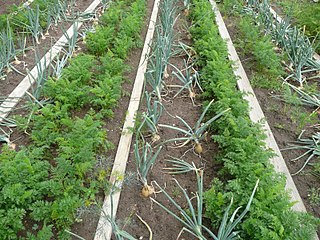 W
WPermaculture is, amongst others, an approach to land management that adopts arrangements observed in flourishing natural ecosystems. It includes a set of design principles derived using whole systems thinking. It uses these principles in fields such as regenerative agriculture, rewilding, and community resilience. Permaculture originally came from "permanent agriculture", but was later adjusted to mean "permanent culture", incorporating social aspects as inspired by Masanobu Fukuoka's natural farming. The term was coined by Bill Mollison and David Holmgren in 1978, who formulated the concept in opposition to Western industrialized methods and in congruence with Indigenous or traditional knowledge.
 W
WAssisted natural regeneration (ANR) is the human protection and preservation of natural tree seedlings in forested areas. Seedlings are, in particular, protected from undergrowth and extremely flammable plants such as Imperata grass. Though there is no formal definition or methodology, the overall goal of ANR is to create and improve forest productivity. It typically involves the reduction or removal of barriers to natural regeneration such as soil degradation, competition with weeds, grasses or other vegetation, and protection against disturbances, which can all interfere with growth. In addition to protection efforts, new trees are planted when needed or wanted. With ANR, forests grow faster than they would naturally, resulting in a significant contribution to carbon sequestration efforts. It also serves as a cheaper alternative to reforestation due to decreased nursery needs.
 W
WConservation agriculture (CA) can be defined by a statement given by the Food and Agriculture Organization of the United Nations as "A farming system that promotes minimum soil disturbance, maintenance of a permanent soil cover, and diversification of plant species. It enhances Biodiversity and natural biological processes above and below the ground surface, which contribute to increased water and nutrient use efficiency and to improved and sustained crop production."
 W
WConservation grazing or targeted grazing is the use of semi-feral or domesticated grazing livestock to maintain and increase the biodiversity of natural or semi-natural grasslands, heathlands, wood pasture, wetlands and many other habitats. Conservation grazing is generally less intensive than practices such as prescribed burning, but still needs to be managed to ensure that overgrazing does not occur. The practice has proven to be beneficial in moderation in restoring and maintaining grassland and heathland ecosystems. The optimal level of grazing will depend on the goal of conservation, and different levels of grazing, alongside other conservation practices, can be used to induce the desired results.
 W
WEcosynthesis is the use of introduced species to fill niches in a disrupted environment, with the aim of increasing the speed of ecological restoration. This decreases the amount of physical damage done in a disrupted landscape. An example is using willow in a stream corridor for sediment and phosphorus capture. It aims to aid ecological restoration, the practice of renewing and restoring degraded, damaged, or destroyed ecosystems and habitats in the environment by active human intervention and action. Humans use ecosynthesis to make environments more suitable for life, through restoration ecology
 W
WHolistic Management in agriculture is an approach to managing resources that was originally developed by Allan Savory. Holistic Management is a registered trademark of Holistic Management International.
 W
WKeyline design is a landscaping technique of maximizing the beneficial use of the water resources of a tract of land. The "keyline" denominates a specific topographic feature related to the natural flow of water on the tract. Keyline design is a system of principles and techniques of developing rural and urban landscapes to optimize use of their water resources.
 W
WNatural farming, also referred to as "the Fukuoka Method", "the natural way of farming" or "do-nothing farming", is an ecological farming approach established by Masanobu Fukuoka (1913–2008). Fukuoka, a Japanese farmer and philosopher, introduced the term in his 1975 book The One-Straw Revolution. The title refers not to lack of effort, but to the avoidance of manufactured inputs and equipment. Natural farming is related to fertility farming, organic farming, sustainable agriculture, agroecology, agroforestry, ecoagriculture and permaculture, but should be distinguished from biodynamic agriculture.
 W
WPolyculture is a form of agriculture in which more than one species is grown at the same time and place in imitation of the diversity of natural ecosystems. Polyculture is the opposite of monoculture, in which only members of one plant or animal species are cultivated together. Polyculture has traditionally been the most prevalent form of agriculture in most parts of the world and is growing in popularity today due to its environmental and health benefits. There are many types of polyculture including annual polycultures such as intercropping and cover cropping, permaculture, and integrated aquaculture. Polyculture is advantageous because of its ability to control pests, weeds, and disease without major chemical inputs. As such, polyculture is considered a sustainable form of agriculture. However, issues with crop yield and biological competition have caused many modern major industrial food producers to continue to rely on monoculture instead.
 W
WRegenerative agriculture is a conservation and rehabilitation approach to food and farming systems. It focuses on topsoil regeneration, increasing biodiversity, improving the water cycle, enhancing ecosystem services, supporting biosequestration, increasing resilience to climate change, and strengthening the health and vitality of farm soil.
 W
WIn agriculture, rotational grazing, as opposed to continuous grazing, describes many systems of pasturing, whereby livestock are moved to portions of the pasture, called paddocks, while the other portions rest. Each paddock must provide all the needs of the livestock, such as food, water and sometimes shade and shelter. The approach often produces lower outputs than more intensive animal farming operations, but requires lower inputs, and therefore sometimes produces higher net farm income per animal.